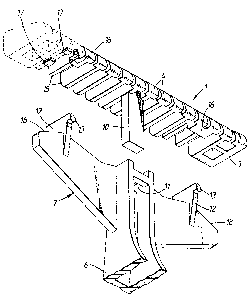Some of the information on this Web page has been provided by external sources. The Government of Canada is not responsible for the accuracy, reliability or currency of the information supplied by external sources. Users wishing to rely upon this information should consult directly with the source of the information. Content provided by external sources is not subject to official languages, privacy and accessibility requirements.
Any discrepancies in the text and image of the Claims and Abstract are due to differing posting times. Text of the Claims and Abstract are posted:
| (12) Patent: | (11) CA 1318119 |
|---|---|
| (21) Application Number: | 1318119 |
| (54) English Title: | SAFETY RAZORS |
| (54) French Title: | RASOIR DE SURETE |
| Status: | Term Expired - Post Grant |
| (51) International Patent Classification (IPC): |
|
|---|---|
| (72) Inventors : |
|
| (73) Owners : |
|
| (71) Applicants : | |
| (74) Agent: | MACRAE & CO. |
| (74) Associate agent: | |
| (45) Issued: | 1993-05-25 |
| (22) Filed Date: | 1988-07-27 |
| Availability of licence: | N/A |
| Dedicated to the Public: | N/A |
| (25) Language of filing: | English |
| Patent Cooperation Treaty (PCT): | No |
|---|
| (30) Application Priority Data: | None |
|---|
ABSTRACT
A safety razor comprising a flexible razor blade unit
secured to a handle by a connection arranged to permit free
flexure of the unit in use of the razor. The connection
comprises a slide for mounting and guiding the unit for
reciprocal movement relative to the handle in a direction
substantially perpendicular to the planes of the blades, the
slide being located at the mid-length of the unit, and further
connections, to either side of the slide, permitting relative
movement of opposite end portions of the unit, relative to the
handle, in directions generally parallel with the blade edges.
With this arrangement, the slide serves to centralize the unit
longitudinally on the handle, whilst permitting free movement of
the central part of the unit towards and away from the handle
and the further connections which are conveniently formed as pin
and slot connections permit concomitant movement of the opposite
end portions of the unit towards and away from each other.
Note: Claims are shown in the official language in which they were submitted.
Note: Descriptions are shown in the official language in which they were submitted.

2024-08-01:As part of the Next Generation Patents (NGP) transition, the Canadian Patents Database (CPD) now contains a more detailed Event History, which replicates the Event Log of our new back-office solution.
Please note that "Inactive:" events refers to events no longer in use in our new back-office solution.
For a clearer understanding of the status of the application/patent presented on this page, the site Disclaimer , as well as the definitions for Patent , Event History , Maintenance Fee and Payment History should be consulted.
| Description | Date |
|---|---|
| Inactive: Expired (old Act Patent) latest possible expiry date | 2010-05-25 |
| Inactive: IPC from MCD | 2006-03-11 |
| Grant by Issuance | 1993-05-25 |
There is no abandonment history.
| Fee Type | Anniversary Year | Due Date | Paid Date |
|---|---|---|---|
| MF (category 1, 5th anniv.) - standard | 1998-05-25 | 1998-04-06 | |
| MF (category 1, 6th anniv.) - standard | 1999-05-25 | 1999-05-03 | |
| MF (category 1, 7th anniv.) - standard | 2000-05-25 | 2000-05-03 | |
| MF (category 1, 8th anniv.) - standard | 2001-05-25 | 2001-05-03 | |
| MF (category 1, 9th anniv.) - standard | 2002-05-27 | 2002-05-02 | |
| MF (category 1, 10th anniv.) - standard | 2003-05-26 | 2003-05-02 | |
| MF (category 1, 11th anniv.) - standard | 2004-05-25 | 2004-05-04 | |
| MF (category 1, 12th anniv.) - standard | 2005-05-25 | 2005-05-04 | |
| MF (category 1, 13th anniv.) - standard | 2006-05-25 | 2006-04-05 | |
| MF (category 1, 14th anniv.) - standard | 2007-05-25 | 2007-04-10 | |
| MF (category 1, 15th anniv.) - standard | 2008-05-26 | 2008-04-07 | |
| MF (category 1, 16th anniv.) - standard | 2009-05-25 | 2009-04-07 |
Note: Records showing the ownership history in alphabetical order.
| Current Owners on Record |
|---|
| THE GILLETTE COMPANY |
| Past Owners on Record |
|---|
| BRIAN OLDROYD |